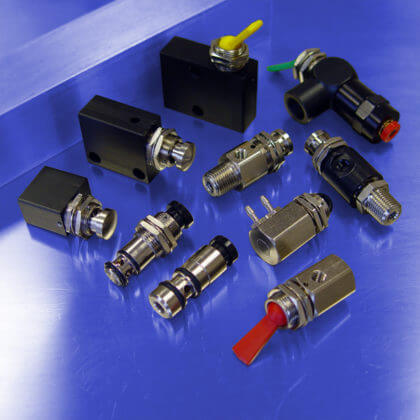Selecting the right valve to control system pressure, direction of flow and rate of flow is crucial when designing fluid power circuitry. Below are the top 5 things that must be considered when specifying directional valves for any pneumatic application.

1. Function
Directional valves are used to control fluid direction within a pneumatic circuit. The action required by your application will determine the type of valve needed.
2. Actuator Style
Depending on your application requirements, a variety of methods are available to actuate a directional valve.
3. Flow Rate
How much flow do you need at the output port of the valve? It is important to know the required flow rate of your application in order to correctly size a directional control valve. If the valve is too big for the application, you will be wasting air & money. If it’s too small, the actuator will not function properly.
Flow rate is typically measured in standard cubic feet per minute (scfm) passing through a valve at a specified operating pressure (psi). Another common measurement is standard cubic feet per hour (scfh).
4. Operating Pressure
The pressure required to operate a directional valve is known as the operating pressure (psi). Since operating pressure greatly affects flow rate, it is important to review the performance data presented by the manufacturer to ensure that a valve will perform as required in your application. For example, at 50 psi a valve can have a flow rate of 9 scfm whereas at 125 psi, the same valve has a flow rate of 20 scfm. Most pneumatic valves are rated for use with vacuum (26” Hg) to 150 psi.
5. Media Compatibility
When using any media other than air, it is important to review the materials of construction to ensure that the internal components and seals are compatible with the fluid passing through the valve.
Also Read: How to Select a Solenoid Valve
Rotating equipment packages such as pumps, compressors, turbines need the lube oil consoles for their…
This article explains how to blink lights in ladder logic with a detailed explanation video…
In this article, a simple example will teach you the conversion from Boolean algebra to…
In this article, you will learn the PLC cooking timer example for kitchen automation using…
Learn an example PLC program to control a pump based on level sensors using ladder…
In the PLC timer application for security camera recording, when motion is detected then camera…